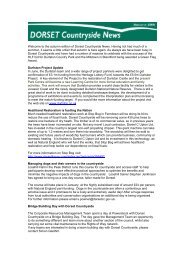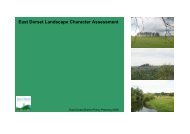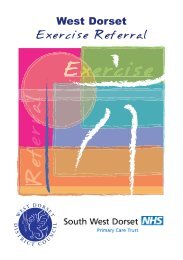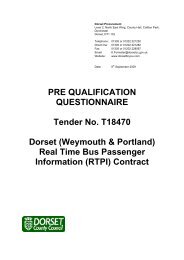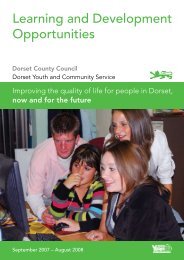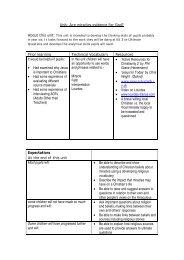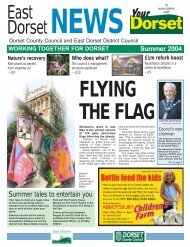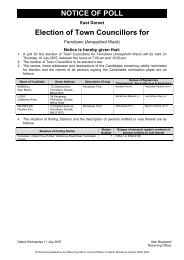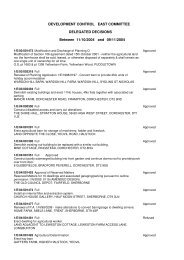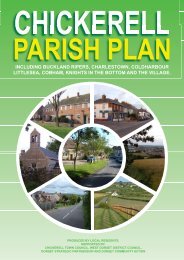Year: 5 and 6 Text type: Persuasive Writing ... - Dorsetforyou.com
Year: 5 and 6 Text type: Persuasive Writing ... - Dorsetforyou.com
Year: 5 and 6 Text type: Persuasive Writing ... - Dorsetforyou.com
Create successful ePaper yourself
Turn your PDF publications into a flip-book with our unique Google optimized e-Paper software.
<strong>Year</strong>: 5 <strong>and</strong> 6<br />
<strong>Text</strong> <strong>type</strong>: <strong>Persuasive</strong> <strong>Writing</strong><br />
(<strong>Year</strong> 5 Non Fiction unit 3)<br />
Duration: 5 – 6 weeks<br />
This is a mixed age planning unit for years 5 <strong>and</strong> 6. The unit has two out<strong>com</strong>es. The<br />
children will work towards writing their own persuasive letter for a real purpose. They<br />
will also create spoken presentation with ICT or other use of multi-modality to support<br />
the presentation. Extension for Y6 pupils includes building the ability to choose the<br />
appropriate style <strong>and</strong> form to suit a specific purpose <strong>and</strong> audience, drawing on<br />
knowledge of different non-fictional text <strong>type</strong>s <strong>and</strong> adapting, conflating <strong>and</strong> <strong>com</strong>bining<br />
these where appropriate.<br />
Progression in Y5 <strong>and</strong> Y6<br />
Children will be<strong>com</strong>e more aware of how writers persuade readers through the use of<br />
persuasive devices including, words <strong>and</strong> phrases, deliberate use of ambiguity, halftruth,<br />
bias, <strong>and</strong> how opinion can be disguised to seem like fact. Opportunities for<br />
persuasion through spoken presentations using ICT will help children consider they<br />
ways in which, text, pictures <strong>and</strong> sounds can be used to persuade particular<br />
audiences.<br />
Overview<br />
Phase 1<br />
Read <strong>and</strong> <strong>com</strong>pare persuasive letters from newspapers <strong>and</strong> magazines, identifying<br />
<strong>and</strong> collecting persuasive devices such as words <strong>and</strong> phrases. Read <strong>and</strong> evaluate a<br />
range of texts, in print <strong>and</strong> other media, on paper <strong>and</strong> on screen (e.g. newspaper<br />
<strong>com</strong>ment, headlines, adverts, fliers) for persuasiveness, clarity, quality of information,<br />
<strong>and</strong> to <strong>com</strong>pare writing which informs <strong>and</strong> persuades.<br />
Phase 2<br />
Prepare <strong>and</strong> present a spoken presentation using ICT <strong>and</strong> other multi-modality<br />
supports. Pupils will evaluate each other’s performances <strong>and</strong> adapt them for<br />
particular audiences.<br />
Phase 3<br />
Write own persuasive letter for a newspaper or magazine based on a real purpose.<br />
Write a <strong>com</strong>mentary on an issue on paper or screen, for example as a news editorial<br />
or leaflet, setting out <strong>and</strong> justifying a personal view.
Objectives<br />
Most children learn to:<br />
1. Speaking<br />
• Present a spoken argument, sequencing points logically, defending<br />
views with evidence <strong>and</strong> making use of persuasive language (Y5)<br />
• Use <strong>and</strong> explore different question <strong>type</strong>s <strong>and</strong> different ways words are<br />
used, including in formal <strong>and</strong> informal contexts (Y5)<br />
• Use a range of oral techniques to present persuasive arguments <strong>and</strong><br />
engaging narratives (Y6)<br />
2. Listening & responding<br />
• Analyse the use of persuasive language (Y5)<br />
• Analyse <strong>and</strong> evaluate how speakers present points effectively through<br />
use of language <strong>and</strong> gesture (Y6)<br />
6. Word structure & spelling<br />
• Spell familiar words correctly <strong>and</strong> employ a range of strategies to spell<br />
difficult <strong>and</strong> unfamiliar words (Y6)<br />
• Use a range of appropriate strategies to edit, proofread <strong>and</strong> correct<br />
spelling in their own work, on paper <strong>and</strong> on screen (Y6)<br />
7. Underst<strong>and</strong>ing <strong>and</strong> interpreting texts<br />
• Infer writers' perspectives from what is written <strong>and</strong> from what is implied (Y5)<br />
• Recognise rhetorical devices used to argue, persuade, mislead <strong>and</strong> sway the<br />
reader (Y6)<br />
8. Engaging with <strong>and</strong> responding to texts<br />
• Compare how a <strong>com</strong>mon theme is presented in poetry, prose <strong>and</strong> other media<br />
(Y5)<br />
9. Creating <strong>and</strong> shaping texts<br />
• Reflect independently <strong>and</strong> critically on their own writing <strong>and</strong> edit <strong>and</strong> improve it<br />
(Y5)<br />
• Integrate words, images <strong>and</strong> sounds imaginatively for different purposes (Y6)<br />
10. <strong>Text</strong> structure <strong>and</strong> organisation<br />
• Experiment with the order of sections <strong>and</strong> paragraphs to achieve different<br />
effects (Y5)<br />
• Change the order of material within a paragraph, moving the topic sentence<br />
(Y5)<br />
• Use varied structures to shape <strong>and</strong> organise text coherently (Y6)<br />
• Use paragraphs to achieve pace <strong>and</strong> emphasis (Y6)<br />
11. Sentence structure <strong>and</strong> punctuation<br />
• Adapt sentence construction to different text-<strong>type</strong>s, purposes <strong>and</strong> readers (Y5)<br />
• Punctuate sentences accurately, including using speech marks <strong>and</strong><br />
apostrophes (Y5)<br />
• Express subtle distinctions of meaning, including hypothesis, speculation <strong>and</strong><br />
supposition, by constructing sentences in varied ways (Y6)<br />
• Use punctuation to clarify meaning in <strong>com</strong>plex sentences (Y6)<br />
12. Presentation<br />
• Adapt h<strong>and</strong>writing for specific purposes, for example printing, use of italics (Y5)<br />
• Use a range of ICT programs to present texts, making informed choices about<br />
which electronic tools to use for different purposes (Y5)<br />
• Use different styles of h<strong>and</strong>writing for different purposes with a range of media,<br />
developing a consistent <strong>and</strong> personal legible style (Y6)<br />
• Select from a wide range of ICT programs to present text effectively <strong>and</strong><br />
<strong>com</strong>municate information <strong>and</strong> ideas (Y6)
Building on previous learning:<br />
Differentiated expectations for a mixed age class would include:<br />
• Are familiar with advertisements <strong>and</strong> the persuasive devices used.<br />
• Able to organise information to support a point of view for both written <strong>and</strong> spoken<br />
presentations <strong>and</strong> debates.<br />
• Be familiar with connectives to structure a persuasive argument.<br />
• Able to design an advert such as a poster or radio jingle.<br />
Teaching Sequence<br />
Phase 1<br />
• Shared reading, evaluating <strong>and</strong> contrasting letters to a local newspaper based on<br />
local issue. E.g. new car park, supermarket etc.<br />
• Shared reading <strong>and</strong> evaluating fliers <strong>and</strong> brochures aimed at persuading the<br />
general public to a view point. E.g. ecological issues, nuclear power, global issues<br />
such fair trade<br />
• Read <strong>and</strong> evaluate letters, for example from newspapers or magazines, intended<br />
to inform, protest, <strong>com</strong>plain, persuade, considering (i) how they are set out, <strong>and</strong><br />
(ii) how language is used (e.g. to gain attention, respect, manipulate).<br />
• Select, read <strong>and</strong> evaluate a range of texts, in print <strong>and</strong> other media, on paper <strong>and</strong><br />
on screen (e.g. newspaper <strong>com</strong>ment, headlines, adverts, fliers) for<br />
persuasiveness, clarity, quality of information, <strong>and</strong> to <strong>com</strong>pare writing which<br />
informs <strong>and</strong> persuades, considering for example the deliberate use of ambiguity,<br />
half-truth, bias; how opinion can be disguised to seem like fact. Infer writers'<br />
perspectives from what is written <strong>and</strong> from what is implied.<br />
• Collect <strong>and</strong> investigate use of persuasive devices such as words <strong>and</strong> phrases<br />
(e.g. 'surely', 'it wouldn't be very difficult...') persuasive definitions (e.g. 'no one but<br />
a <strong>com</strong>plete idiot...', 'every right-thinking person would..., 'the real truth is...'),<br />
rhetorical questions (e.g. 'are we expected to...?', 'where will future audiences<br />
<strong>com</strong>e from...?'), p<strong>and</strong>ering, condescension, concession (e.g. 'naturally it takes<br />
time for local residents...'), deliberate ambiguities (e.g. 'probably the best...in the<br />
world', 'known to cure all...', 'the professional's choice').<br />
• Working in pairs sort collected words <strong>and</strong> phrases into categories e.g. suitable to<br />
use for particular audiences.<br />
• Play speaking <strong>and</strong> listening games where persuasion is used orally. E.g. hot air<br />
balloon debates, Room 101, what would you rather be … hammer or nail etc.<br />
Encourage the use <strong>and</strong> identification of key phrases used for persuasion.<br />
Phase 2<br />
• Construct an argument in note form to persuade others of a point of view,<br />
sequencing points logically. Explore how ICT or other use of multimodality might<br />
support this (e.g. develop a PowerPoint presentation). Present as a spoken<br />
argument to the class or a group making use of persuasive language. Listen to<br />
others doing the same <strong>and</strong> evaluate own <strong>and</strong> others' presentations.<br />
• Prepare an oral presentation for governors, headteacher or school council, on a<br />
school issue e.g. how an area of the playground should be developed, strategies<br />
for tackling bullying. Identify how language needs to change for different <strong>and</strong> more<br />
formal contexts.<br />
• Write a <strong>com</strong>mentary on an issue on paper or screen, for example as a news<br />
editorial or leaflet, setting out <strong>and</strong> justifying a personal view. Use structures from<br />
reading to set out <strong>and</strong> link points (e.g. numbered lists, bullet points).
Phase 3<br />
• Underst<strong>and</strong> how persuasive writing can be adapted for different audiences <strong>and</strong><br />
purposes (e.g. by using formal language where appropriate), <strong>and</strong> how it can be<br />
incorporated into or <strong>com</strong>bined with other text <strong>type</strong>s.<br />
• Shared writing – change a letter <strong>and</strong> filer text by changing the nature of the<br />
audience it addresses. Ask the children to identify key changes to help maintain<br />
the persuasion<br />
• Working in pairs adapt an letter to persuade a particular audience.<br />
• Draft <strong>and</strong> write individual, group or class persuasive letters for real purposes, for<br />
example put a point of view, <strong>com</strong>ment on an emotive issue, protest; edit <strong>and</strong><br />
present to finished state.<br />
• Write a letter to the local press on issue which affects the pupils, e.g. dog mess in<br />
local playground, safe walking routes to school.<br />
• Write a letter to a national newspaper on a national or global issue – e.g.<br />
extending the UNICEF rights of the child to all countries




